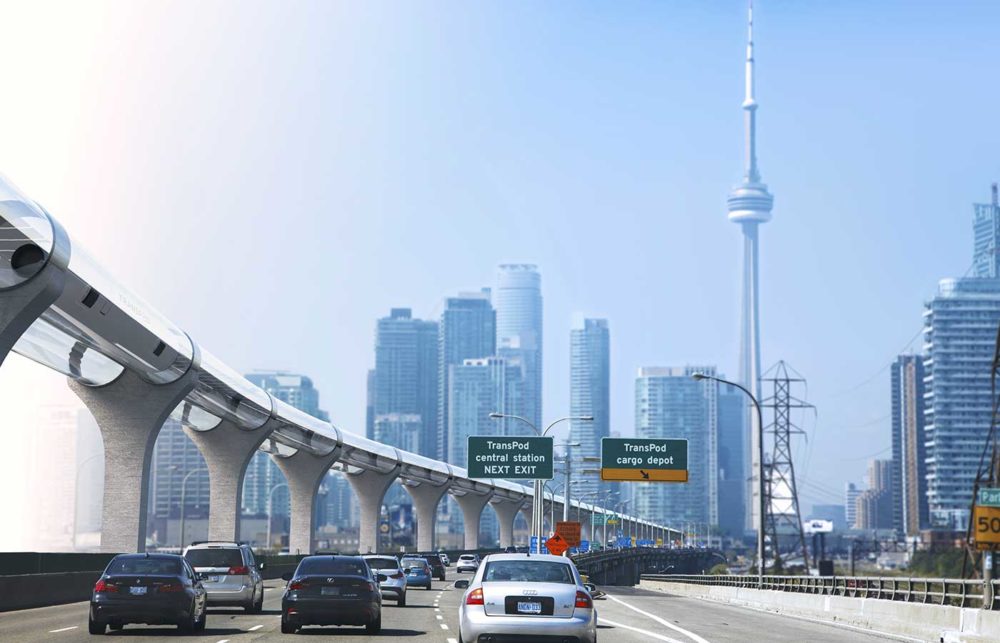Sébastien Gendron, Transpod: hyperloop, a plane without wings – March 2022
Sébastien Gendron, Transpod: hyperloop, a plane without wings – March 2022
Funding of US$550 million secured to finance a proposed line in Alberta between Edmonton and Calgary, a subsidiary created in the Emirates, and the first prototype to be presented in Toronto in July… 2022 is looking promising for TransPod, the company developing the Canadian ‘Hyperloop’ project.
In March 2022, the Futura-Mobility community welcomed in person Sébastien Gendron, co-founder and CEO of TransPod, to rediscover and discuss this transport system in the making…
“The overall aim of the project is to develop a new mode of transport,” explains Mr Gendron. “We think it’ll be complicated for high-speed trains to go beyond 300km/hr. If we want to make progress with tomorrow’s land transport, we have to review the plans.”
The concept of transport by tube has been around for years. SwissMetro is just one example, even though the company went out of business in 2008 after the financial crash. Then in 2013, Elon Musk gave new impetus to the idea by encouraging companies and industry to take the plunge. In 2015, he launched a call to tender open to professionals and students alike. “At this point, I had hopes of raising funding with SpaceX [company founded by Elon Musk in 2002] but they were shortlived,” explains Mr Gendron. “In December 2015, he changed the rules of the game. The call to tender was altered into a competition for students and universities only, so henceforth excluding professionals.”
But all was not lost! Mr Gendron bounced back by joining forces with students from University of Toronto. He met his future associate Ryan Janzen, now Chief Technical Officer at TransPod – “together we make a good duo.” So now the project could kick off.
Finally, after taking part in the Railway Research conference in Milan in 2016, TransPod raised US$15 million with an Italian investor, Angelo Investments, and three of its companies, Blackshape, MERMEC, and SITAEL.

Proving market appetite
Since then, TransPod has continued developing. Its milestones include opening a subsidiary in France in 2019 then, in 2020, a major boost with the signing of a memorandum with the governement of Alberta. According to the agreement, if TransPod brings private funding to the table, the government will help the company carry out the project. “The way this memorandum is structured follows recommendations from certain stakeholders, like La Caisse des Dépôts de Québec for instance, which made it very clear to us that it wasn’t enough to have the best technology in the world. If there wasn’t any market, any appetite, we wouldn’t get far.”
“It was good advice,” acknowledges Mr Gendron. “Once we had signed this memorandum, there was appetite from certain institutions, of which Broughton Capital Group [a British investment fund] which made this offer of US$550 million after over a year of discussions.” The financing is special: Broughton Capital wanted a US$250 million guarantee in exchange for putting part of its funding at risk. CERIECO, a State-owned, Chinese import-export company is providing the financial guarantee requested, which it in turn is obtaining from the Bank of China.
The risk is limited by a plan B in case the technonlogy finally might not work. This plan B envisages transforming the initial infrastructure into a high-speed train line between Edmonton and Calgary.
BPI France and even Export Development Canada, consulted beforehand, chose not to provide the financial guarantee, even though the counterpart proposed by TransPod was to award up to $250 billion of contracts to national companies. “It’s not a question of economic hegemony from China, it’s first and foremost a question of attitude: seeing the glass half full rather than half empty… it’s a pity since this means countries in the West are incapable of taking risks and so, clearly, don’t innovate,” analyses Mr Gendron.
A team with different profiles
Building up a strong team has also been a priority for the co-founder of TransPod. “It’s really important to be surrounded by people smarter than oneself and who complement each other,” advises Mr Gendron. While his associate Ryan Janzen is responsible for the TransPod system architecture and filing patents, he himself deals with running the company, seeking funding and talking with the political field. Mr Gendron is delighted with the multidisciplinarity of his highly international team: “we have every nationality and it’s really rich. Toronto is a pool. We have Iranians, Russians, a French, a Swedish…. The greater the diversity – be it gender or culture – the better it is.”
Design and concept – the devil’s in the details
Put simply,“it’s not a new train. It’s a plane without wings,” explains Mr Gendron. “We’ve discussed the overall vehicle design for 2025 with Airbus Atlantique, the Airbus subsidiary. There are three sub-systems needed for it to work: levitation, propulsion, and power transmission, for which TransPod has the patents.”
Right from the start, TransPod aimed to concentrate all the technology on the vehicle to “keep the infrastructure as simple as possible and so reduce the infrastructure costs to a minimum.”.
The infrastructure under development comprises metal tubes – instead of concrete, because for the levitation and propulsion systems, steel is vital – four metres in diameter, at low pressure to overcome aerodynamic friction. Solar panels are also part of the system.
The structure can be raised over the ground or built underground. For this part of the project, TransPod is working with SADE, the French public works company, which develops semi-underground techniques with small tunnel boring machines: “Semi-underground is a solution that could interest countries in Europe, for instance, whereTransPod infrastructure might be considered visual pollution,” reckons Mr Gendron.
With regards system use, two vehicle types are planned: one for passengers, with an inital capacity for 50 pax, and another for cargo.
The vehicle to be unveiled in July 2022 will be at 1/3 scale, i.e. five metres long, weighing half a tonne, and nearly two metres high. It will integrate some 15 sub-systems; the full vehicle between 40 and 45.
“Our strategy is quite similar to that of Boeing and Airbus with their 320 and 737 families [airliners with shorter and longer aircraft models]. Depending on the passenger or cargo demand, we can extend or reduce the length of the vehicle,” explains Mr Gendron. “We are being quite cautious about vehicle capacity because we really want it to meet real demand for the service line in question.”
To ensure the TransPod lines prove profitable, the company’s CEO is convinced the freight factor is crucial, that the infrastructure must be used continuously. “Combining cargo and passengers is the ideal solution TransPod has found to guarantee the profitability of future lines.” So for the Calgary-Edmonton corridor, for instance, 60% of the traffic will be ‘time sensitive’ cargo, i.e. mainly online shopping and food. Companies currently taking an interest in the project include DHL, Fedex, and Amazon.
“As for certification, TransPod’s first dossier will be for cargo,” adds Mr Gendron.

Infrastructure and the business model – specific features of TransPod
One aspect that stands out, TransPod is focusing on the infrastructure project even that its technology doesn’t yet exisit. “As a private company rather than a private initiative, we can’t finanacially afford to wait until the technology is ready to go before looking where to do the infrastructure project,” explains Mr Gendron. “We want to have a first segment of the infrastructure ready to be able to test the tech as soon as it’s ready.”
Furthermore, the company’s business model differs from that of traditional manufacturers. To increase its profitability, TransPod is, on the one hand, counting on its technology subsidiary, in charge of designing the vehicles, with an eye to building and selling transport vehicles to operators – like, why not to SNCF (French Railways) in the future? Meanwhile, on the other hand, it has the business generated by its subsidiaries abroad, which are looking to develop infrastructure projects. “We aim to have a significant stake in the infrastructure projects all over the world. This will greatly boost the profitability of the TransPod company,” adds Mr Gendron.
Roll-out in a future not so distant
Right now for Alberta, TransPod is starting on land acquisition, the environmental study and taking all the other administrative steps. Next, construction could well kick off in the summer of 2023.
“2025 is our target for having two or three scale 1 protypes ready, followed by two years of trials and testing, then certification in 2027,” envisages Mr Gendron. “If this timetable works out, the first line, between Edmonton and Calgary, could open between 2030 and 2035. It’s ambitious, we don’t master everything today, but disruptive innovation means taking risks!”
Images ©TransPod 2022

